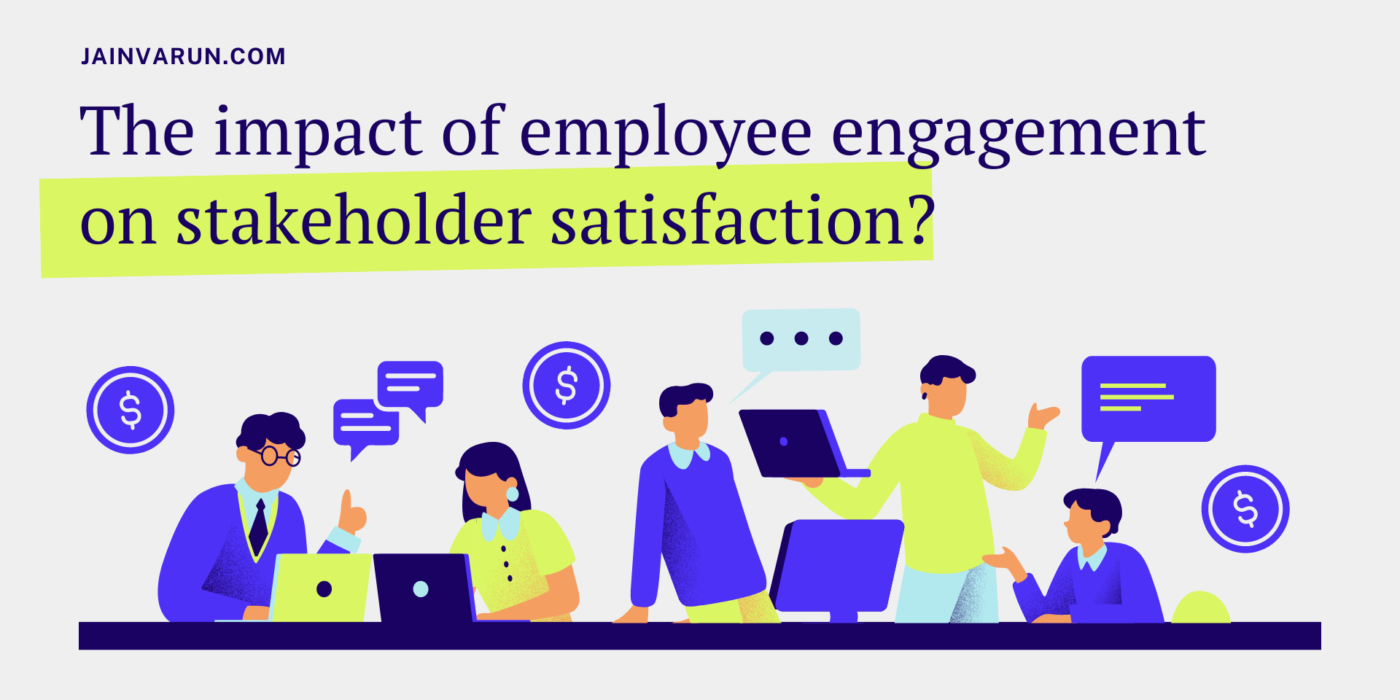Employee engagement isn’t just a buzzword; it’s the secret sauce that can transform an ordinary workplace into an extraordinary one. Imagine a team that’s not just clocking in and out but is genuinely excited about what they do. It’s like the difference between a lacklustre office potluck and a Michelin-starred feast. So, how do you measure and report the impact of this magical ingredient on stakeholder satisfaction? Let’s break it down with a bit of humour, some relatable examples, and a touch of simplicity.
Benefits of Employee Engagement
First things first, why should you even care about employee engagement? Well, think of it as the fuel that powers your company’s engine. Here are some perks:
1. Increased Productivity: Engaged employees are like well-oiled machines—efficient and effective. They get stuff done and then some. For example, an engaged marketing team might not only meet their campaign deadlines but also come up with a creative viral video that propels your brand into the spotlight.
2. Enhanced Innovation: When people are excited about their work, they’re more likely to come up with those “Eureka!” moments that lead to groundbreaking ideas. Consider how Google’s famous 20% time policy, which encourages employees to spend 20% of their work hours on passion projects, has led to innovations like Gmail and Google News.
3. Improved Customer Satisfaction: Happy employees = happy customers. It’s as simple as that. When your team loves their work, it shows in their interactions with customers. Think of a barista at your favourite coffee shop who remembers your order and makes your day with a smile. Their enthusiasm translates into a better customer experience.
4. Lower Turnover Rates: Ever felt like your office has a revolving door? Engagement helps keep that door shut, saving you from constantly training new hires. For example, companies like Zappos prioritize employee happiness and engagement, resulting in lower turnover rates and a more stable, experienced workforce.
5. Stronger Team Collaboration: Engaged employees are like a superhero team, each bringing their unique powers to tackle challenges together. Imagine a project where team members willingly go the extra mile to help each other, leading to seamless collaboration and impressive results.
Challenges of Employee Engagement
Of course, not everything is sunshine and rainbows. Engaging employees can sometimes feel like herding cats. Here are some common hurdles:
1. Leadership Disconnect: If your leaders are in an ivory tower, oblivious to the ground realities, it’s a recipe for disengagement. Picture a ship where the captain never leaves the cabin. To bridge this gap, leaders need to engage with employees regularly, understand their challenges and celebrate their successes.
2. Communication Barriers: Ever played a game of telephone? Poor communication can turn important messages into a garbled mess, leaving employees confused and frustrated. Implementing clear, open communication channels, such as regular town hall meetings and accessible intranets, can help mitigate this issue.
3. Lack of Resources: Imagine trying to bake a cake without the right ingredients. Without adequate resources, employees can’t perform to the best of their abilities. Providing the necessary tools, training, and support is crucial for maintaining high engagement levels.
4. Resistance to Change: People can be as stubborn as a mule when it comes to change. It’s natural but needs to be managed carefully. Introducing changes gradually and involving employees in the decision-making process can help ease transitions.
5. Measuring Engagement: It’s not always easy to quantify feelings and attitudes. Measuring engagement can sometimes feel like catching smoke with your bare hands. However, with the right tools and methodologies, it’s possible to get a clear picture.
Best Practices for Employee Engagement
Now that we’ve covered the good and the not-so-good, let’s talk about how to keep your team engaged and enthusiastic.
1. Transparent Communication: Think of communication as the glue holding your team together. Be open and honest. It builds trust and prevents those pesky rumors. For example, a monthly newsletter from the CEO can keep everyone informed about company developments and future plans.
2. Recognition and Rewards: Everyone loves a pat on the back. Regularly acknowledge and reward your team’s efforts. It’s like giving them a gold star. This could be as simple as a shout-out in a team meeting or as significant as an employee of the month award with perks.
3. Professional Development: Invest in your team’s growth. It’s like watering a plant—nurture them, and they’ll bloom. Offering workshops, courses, and mentorship programs can help employees develop new skills and advance their careers.
4. Work-Life Balance: Don’t let work become a four-letter word. Encourage a healthy balance to keep burnout at bay. Flexible working hours, remote work options, and wellness programs can significantly improve work-life balance.
5. Employee Involvement: Involve your team in decisions. It’s their company too, after all. Creating committees or working groups for various projects can give employees a sense of ownership and investment in the company’s success.
6. Feedback Mechanisms: Set up regular feedback loops. It’s like having a GPS for your engagement efforts—helps you stay on track. This could be through surveys, suggestion boxes, or regular one-on-one meetings.
How to Measure Employee Engagement
You’ve got your team all fired up. Now, how do you measure that spark? Here are some effective methods:
1. Employee Surveys: These are your go-to tool. Ask your team how they’re feeling about their work and the workplace. For example, you might ask questions like, “Do you feel valued at work?” or “Do you have the resources you need to do your job well?” Surveys can be conducted annually or semi-annually, and the data collected can provide valuable insights into employee sentiment.
2. Pulse Surveys: Think of these as quick check-ins. Short, frequent surveys that capture the current mood. They’re less comprehensive than annual surveys but provide timely insights into employee morale and engagement. For instance, a weekly pulse survey might ask, “How was your week?” or “What challenges did you face this week?”
3. Net Promoter Score (NPS): Ask employees how likely they are to recommend your company as a great place to work. It’s like asking, “Would you swipe right on us?” This simple question can reveal a lot about overall satisfaction. A high employee NPS indicates a positive workplace culture, while a low score highlights areas needing improvement.
4. Turnover Rates: If people are sticking around, you’re doing something right. High engagement often means low turnover. For example, if you notice a significant drop in resignation rates after implementing a new engagement initiative, it’s a good sign your efforts are paying off.
5. Performance Metrics: Track productivity, absenteeism, and the quality of work. Engaged employees tend to excel in these areas. For instance, a team with high engagement might consistently meet or exceed their targets, take fewer sick days, and produce higher-quality work.
6. Focus Groups: Dive deeper with small group discussions. They can reveal insights that surveys might miss. For example, a focus group discussion might uncover specific issues affecting a particular department, such as outdated technology or unclear communication from management.
How to Report Employee Engagement
Finally, you need to share the good news (or the areas for improvement) with stakeholders. Here’s how to do it without putting them to sleep:
1. Clear Metrics: Use easy-to-understand metrics. No one wants to decipher a PhD thesis. For instance, instead of presenting a complex statistical analysis, you might use simple graphs and percentages to illustrate engagement levels.
2. Dashboards: Visuals are your friend. Create dashboards that provide real-time insights at a glance. Tools like Tableau or Power BI can help you build interactive dashboards that make data easily accessible and understandable.
3. Narrative Reports: Tell a story. Use qualitative data to complement the numbers and highlight specific successes and challenges. For example, share anecdotes about how a particular engagement initiative boosted team morale or led to a successful project outcome.
4. Regular Updates: Keep stakeholders in the loop with regular updates. No one likes surprises (unless it’s their birthday). Monthly or quarterly reports can keep everyone informed about ongoing engagement efforts and their impact.
5. Action Plans: Share what you’re doing about the engagement data. It shows you’re serious about making improvements. For example, if a survey reveals that employees feel undervalued, outline steps you’ll take to improve recognition and reward programs.
6. Benchmarking: Compare your engagement levels with industry standards. It provides context and highlights where you stand. For instance, if your engagement scores are higher than the industry average, it’s a great selling point for potential recruits and investors.
Additional Considerations for Measuring and Reporting Employee Engagement
1. Linking Engagement to Performance: Establish clear connections between engagement metrics and business performance indicators. For example, show how increased engagement has led to higher sales, improved customer satisfaction scores, or enhanced innovation.
2. Tailoring Reports for Different Stakeholders: Customize your reports to address the specific interests and concerns of different stakeholder groups. Executives might be more interested in the impact of engagement on financial performance, while team leaders might want to see data related to productivity and team morale.
3. Continuous Improvement: Use engagement data to drive continuous improvement initiatives, fostering a culture of ongoing enhancement. For example, if survey results indicate a need for better communication, you might implement regular team briefings and evaluate their effectiveness over time.
4. Technology Utilization: Leverage advanced technologies, such as AI and data analytics, to gain deeper insights and improve the accuracy of engagement measurements. For instance, AI can help analyze open-ended survey responses to identify common themes and sentiments.
5. Employee Testimonials: Incorporate employee testimonials and case studies to provide a human perspective on engagement initiatives and their outcomes. Real stories from real people make the data come alive and can be particularly persuasive for stakeholders.
Conclusion
Measuring and reporting the impact of employee engagement on stakeholder satisfaction isn’t just about crunching numbers. It’s about understanding and nurturing the human side of your organization. By focusing on transparent communication, recognition, development, and continuous feedback, you can create an engaged workforce that drives your company’s success. So, put on your engagement superhero cape and get to work! The satisfaction of your stakeholders—and the health of your organization—depends on it.












